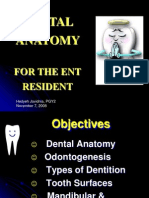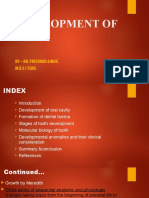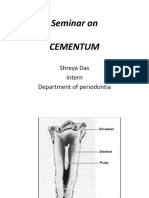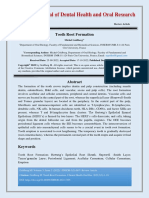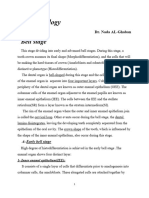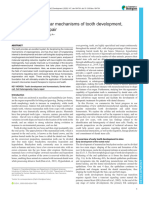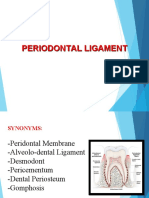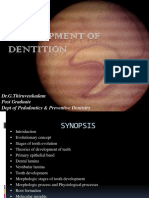0 Enamel Factoid
0 Enamel Factoid
Uploaded by
moffittajCopyright:
Available Formats
0 Enamel Factoid
0 Enamel Factoid
Uploaded by
moffittajCopyright
Available Formats
Share this document
Did you find this document useful?
Is this content inappropriate?
Copyright:
Available Formats
0 Enamel Factoid
0 Enamel Factoid
Uploaded by
moffittajCopyright:
Available Formats
Charles F.
Cox, DMD, PhD
Director, Research & Development
Phoenix Dental Inc. Fenton, Michigan
ENAMEL FACTOID
This FACTOID focuses upon the morphology & physiology of human enamel—a
non-vital mineralized tissue that cannot repair itself—Craig & Peyton (1958) reported
the general hardness of enamel at 343-KHN + 23 std dev (Knoop hardness diamond
indentation)—the greatest deviation was always noted just below the occlusal surface
& an average compressive strength of 55,700 Psi.
In the US, clinicians like H.H. Hayden (1825), C.A. Harris (1839), M.H. Webb
(1882) & G.V. Black (1883), J.L. Williams (1896) & T.B. Beust (1911) published their
observations of enamel while studying human caries on extracted teeth—a famous
1882 photograph shows Dr. Black sitting in his upstairs laboratory at a sectioning
device of his own design. Microscopic tissue fixation & processing for thin section
histology (3-7µm) was still in its infancy—many reagents caused shrinkage, distortion
& interfered with staining reactions—enamel could only be studied by ground section
as the mineral substrate is lost with acid demineralization. Europeans—A.P. van
Leeuwenhoek (1716), A. Nasmyth (1839), Sir John C. Tomes (1849), R.A. Kölliker
(1853), J.E. Oudet (1862), L. Raschkow (1835), A.A. Retzius (1837), E. Magitot (1872),
H. Lams (1921) & C.F. Bödecker (1923) also published articles on enamel morphology.
Enamel is the only mineralized human tissue that develops from epithelial cells
that had proceeded through developmental stages into individual bell (cell) shapes,
which invaginated inwards—like pushing your finger into the bottom of a balloon to
create an inner layer—that forms a layer of inner enamel epithelial (IEE) cells, which
continues to cause reciprocal shifts of proteins to trigger morphodifferentiation of the
invaginated layer of IEE into ameloblasts. Following the first deposit of a few µm of
dentine matrix at the cusp tip, ameloblasts then deposit an enamelin matrix that
rapidly mineralizes at the cusp tip—composed of a unique arrangement of millions of
calcium-hydroxyapatite (CaHA) crystals that coalesce into a single rod (prism),
whereas rods are least mineralized at the cervical margin. Each enamel rod is a long
thin prism that projects from the EDJ to the oral surface—mid-crown rod length is
about 2-mm & the rod diameter is only about 5µm. Ground sections reveal that
enamel is formed about 4µm per day along its rod length. Enamel is a dense, rigid
cap (99.2% mineral – 0.15%-0,8% organic H.C. Hodge 1938) that ends at the cervical-
Copyright, Phoenix Dental Inc. 2010, Dr. Charles F. Cox 1
Charles F. Cox, DMD, PhD
Director, Research & Development
Phoenix Dental Inc. Fenton, Michigan
gum margin. When enamel formation is complete, IEE cells become part of the
epithelial cervical-loop cells, which provides induction to pulp cells to form
odontoblasts that continue to form root dentine—these cervical loop cells later split
into epithelial rest cells of Hertwig or Cerres, to provide an inductive response that
stimulates a thin layer of acellular (epithelial) cementum to cover the root dentine,
followed later by cellular cementum deposition of mesenchymal origin (Furseth 1974).
The clinical enamel crown—seen below—is the visible part of the tooth that shows
in the oral cavity—due to its dense CaHA mineral composition, it varies in color from
very white in primary (deciduous) teeth to light yellow & dark gray in permanent teeth
that continue to become darker as the tooth ages with continued deposition of
secondary dentine. Enamel is approx. 3.0 mm thick at the cusp tip & tapers off to a
thin ―feather‖ edge at the cervical margin where it ends at the enamel-cementum
junction. X-ray data by Thewlis (1938) reported a ―thin strip of hypercalcified enamel
on the surface. . . .there is a gradual increase in calcification from the amelo-dentinal
junction to the outer hypercalcified layer.‖
Enamel forms by deposition of CaHA needlelike crystals around an organic
amelogenin protein scaffold during enamel maturation development—adult enamel
contains several unique morphological features such as rods, gnarled rods, tufts,
lamella, spindles, EDJunction, incremental striae of Retzius & perikymata.
Each enamel rod (prism) has an undulating course from the EDJ to the oral surface
& is ―keyhole‖ shaped with a head, neck & tail, being composed of millions of small
CaHA needlelike crystals—each being oriented with their long axis parallel to the rod.
The peripheral CaHA crystals fan-out towards the tail with nano-amounts of inter-rod
Copyright, Phoenix Dental Inc. 2010, Dr. Charles F. Cox 2
Charles F. Cox, DMD, PhD
Director, Research & Development
Phoenix Dental Inc. Fenton, Michigan
proteins called amelogenins—enamelins in mature enamel—are located along each
rod periphery, some of these proteins remain as part of the organic lamellar sheath
that extends outwards from the EDJ to the oral surface. As the enamel forming
ameloblasts project off from the EDJ interface, there is no typical adult type of rod
structure—the distal portion of the ameloblast cell has not yet been able to form a
terminal ―Tomes‖ process that is responsible to form the adult rod structure. However,
after a few days of 5 to 8µm of initial deposition, the Tomes apparatus of each cell
begins to define each rod shape. In the last phase of enamel rod formation within
30µm near the oral surface, ameloblasts lose its rod-form—primary tooth enamel is
rodless, whereas the cervical 1/3 of enamel in permanent teeth is without any defined
rod form.
Gnarled enamel rods are seen in all teeth as a dense twisted arrangement of rods
that specifically project from the cuspal & incisal EDJ interface to form a complex
arrangement of intertwined rods. It has been speculated that the gnarled arrangement
provides for an increased degree of rigid support against fracture during biting,
chewing & all other masticatory forces that are placed on the enamel.
Tufts—different than rod gnarling—are unique structural features of enamel that
project as intertwined twists of rods from the EDJ that project for about 1/3 of the
enamel thickness, being most numerous at the cusp tips & contain greater amounts of
enamel protein than non-tuft enamel. Beust demonstrated (1911) enamel tufts in all
human tooth types using an ROH-basic-fuchsin stain & speculated tuft form due to
abrupt changes of rod direction as they project off the EDJ interface. Nakamura
(2009) has speculated that enamel tufts form when blood proteins became lodged &
condense during initiation & could not be degraded by enamel proteineases—allowing
them to remain in the spirals of tufts & to then condense during the crystallization
phase.
Enamel spindles are random projections of a single odontoblast process that cross
the basement membrane at the cuspal EDJ during matrix deposition, leaving a
dentine tubule-like spindle of mesenchymal tissue—with an organic protein (collagen)
content unlike the surrounding enamel. Lester (1967) reported that enamel spindles
could not be found in the bulk of circumpulpal dentine but speculated that these fiber
Copyright, Phoenix Dental Inc. 2010, Dr. Charles F. Cox 3
Charles F. Cox, DMD, PhD
Director, Research & Development
Phoenix Dental Inc. Fenton, Michigan
bundles penetrate the basement membrane of the EDJ as a consequence of a rapid
build-up of proliferative cell growth of the dental pulp, speculating that enamel
spindles are of mesenchymal origin. Several clinical reports have noted that in adult
teeth, enamel spindles are often associated with areas of extreme hypersensitivity
during cavity preparation, as well as that they are potential sites of bacterial
penetration into dentine along & through the EDJ interface.
Enamel lamella were first described in 1838 by Professor Nasmyth as an organic
sheath (fin) that course across from labial to lingual in the substance of enamel—
generally found at the base of occlusal pits & fissures. Beust (1913) later described
lamella as ―canals of random shaped fissures that lie between the rods that served as
diffusion currents. . . .noting the interrod protein substance was colorable by certain
stains & with increasing age the color disappears—indicating further enamel sclerosis
after eruption.‖ Lamella have been shown to be developmental remnants of thin
sheets of organic proteins that begin at the EDJ—coursing throughout the enamel to
the enamel surface from the labial cervical margin to the lingual cervical edge—most
numerous in the cusp & incisal tips. On the other hand, environmental conditions
such as cold water, ice cream & cold drinks can easily create thermal stress of
sufficient magnitude to cause cracks in enamel that easily allow biofilm colonization,
which may easily lead to caries (Lloyd et al 1978). In essence, these organic lamellar
sheaths are pathways for the inward & outward diffusion of not only fluids but also to
the proliferation of microorganisms to the EDJ, where they may then spread laterally
along the EDJ interface & penetrate into the dentine tubule complex. Enamel lamella
appear to be developmental remnants & often appear to be sites of increased
vulnerability to bacterial biofilm invasion & eventual caries.
As soon as the individual begins to eat & drink low pH agents, the enamel lamellae
protein sheath may become altered or even lost—leaving an open permeable space
that rapidly becomes colonized with a biofilm of bacteria—some of which colonize the
lamellae & other defects to immediately begin to proliferate & migrate towards the
EDJ. Certain of the acid-producing bacteria may rapidly secrete organic acids e.g.
lactic or butyric that etch the lamella walls that widens the space & allows more
opportunistic bacteria to occupy the space. If these bacteria are fed sugars in the
Copyright, Phoenix Dental Inc. 2010, Dr. Charles F. Cox 4
Charles F. Cox, DMD, PhD
Director, Research & Development
Phoenix Dental Inc. Fenton, Michigan
absence of proper oral hygiene then a rapid caries response will rapidly result. On the
other hand, if caries is halted, many of the normal salivary electrolytes (calcium,
potassium, bicarbonate & phosphates) may easily bath the lamella spaces, & easily
become a calcified sclerotic mass that serves as a biological plug to seal the leaky
space. The person’s intake of acidic juices & soft drinks that contains H 3PO4, which
dissolves the organic lamella & the enamel crystals directly adjacent to the lamellae
space. This space permits fluids & bacteria to enter through the open lamellae space
to the EDJ. A research study by Bartlestone (1947) using radiolabelled Iodine tracers
reported a rapid penetration of label through the lamellae cracks to the EDJ interface,
through the dentine tubule complex & through the vital odontoblast layer to enter into
the pulp vasculature & pass throughout the body’s bloodstream. These agents
became lodged in cells, they were measured in body tissues—only 15-minutes after
placement of the tracer onto the enamel surface.
The EDJunction is a scalloped interface that is a remnant from the basement
membrane between the epithelial & mesenchymal tissues. SEM data have shown the
EDJ as a series of cratered ridges that increase the adhesion of enamel to dentine
due to the increased surface area.
Striae of Retzius are seen as incremental growth lines that are most prominent in
mature permanent teeth, a lesser amount in postnatal deciduous enamel &
uncommon in prenatal enamel. Enamel at birth generally shows an incremental
neonatal-line due to metabolic changes during the delivery process.
Perikymata are shallow surface furrow manifestations of the striae of Retzius on the
oral surface of enamel that run circumferentially across the face of the crown.
Copyright, Phoenix Dental Inc. 2010, Dr. Charles F. Cox 5
Charles F. Cox, DMD, PhD
Director, Research & Development
Phoenix Dental Inc. Fenton, Michigan
The photomicrographs are from a 1998 study by Walker et al. The top left photo is a
radiograph from a human molar that failed to show any proximal caries radiolucency
of either the enamel or dentine before any staining & sectioning. The same molar
was then immersed in a concentrated Orange-G solution for 24-hours, placed in
resin, ground sectioned at approximately 100µm & observed under incident light.
The photo above right is a ground cross-section through the same human molar
tooth that shows a lamella traversing from the oral surface through the entire enamel
thickness to the EDJunction. The Orange-G is seen to heavily stain the carious
dentine that spreads along the EDJ & deeper into the tubule complex, which was
seen with oral transillumination, but was failed to be observed in the initial X-ray.
The bottom right photo is a 100µm Orange-G stained longitudinal ground section
through an adult human tooth that shows a carious lesion that has spread through
the dentine that is seen directly below the enamel lamella.
The 1998 Walker study reported ―the enamel lamella are shown to be a
permeable pathway allowing caries-producing bacteria access to the entire
dentine-enamel junction. . . .Caries can thus be established within the tooth
without visible evidence at the surface.‖
Copyright, Phoenix Dental Inc. 2010, Dr. Charles F. Cox 6
You might also like
- Kama SutraDocument96 pagesKama SutraAnderson London100% (1)
- Difference Between Policy and StrategyDocument4 pagesDifference Between Policy and StrategyAbu Taleb83% (6)
- Final PDLDocument100 pagesFinal PDLDrRahat SaleemNo ratings yet
- Soap NotesDocument4 pagesSoap NotesLatora Gardner Boswell100% (3)
- Hobsbawm, E. J. (1972) - The Social Function of The Past: Some Questions, Past and Present N. 55Document15 pagesHobsbawm, E. J. (1972) - The Social Function of The Past: Some Questions, Past and Present N. 55Naroa AretxabalaNo ratings yet
- A Dictionary of Jewish Babylonian AramaicDocument26 pagesA Dictionary of Jewish Babylonian Aramaicsedra12No ratings yet
- Lecture 2 - 1Document9 pagesLecture 2 - 1ahmedfawakh0No ratings yet
- Congenital Anomalies - 2016 - Kawashima - Odontoblasts Specialized Hard Tissue Forming Cells in The Dentin Pulp ComplexDocument10 pagesCongenital Anomalies - 2016 - Kawashima - Odontoblasts Specialized Hard Tissue Forming Cells in The Dentin Pulp ComplexDevin KwanNo ratings yet
- Basic Science Anatomy of The ToothDocument44 pagesBasic Science Anatomy of The ToothAmmar Al ZoubiNo ratings yet
- Tooth Formation: Chapter 1Document5 pagesTooth Formation: Chapter 1_RedX_No ratings yet
- Cho 2000Document19 pagesCho 2000Juanpablo SanchezNo ratings yet
- Tooth Development and Growth One Lecture 2023Document80 pagesTooth Development and Growth One Lecture 2023Rabeea KittaniNo ratings yet
- Articulo 5Document8 pagesArticulo 5FernierNo ratings yet
- Development of Teeth: by - Dr. Priyanka Singh. M.D.S I YearDocument61 pagesDevelopment of Teeth: by - Dr. Priyanka Singh. M.D.S I YearJerry TurtleNo ratings yet
- Stages of Tooth DevelopementDocument45 pagesStages of Tooth Developementydvayushi31No ratings yet
- Seminar On Cementum: Shreya Das Intern Department of PeriodontiaDocument57 pagesSeminar On Cementum: Shreya Das Intern Department of Periodontiashreya dasNo ratings yet
- Teeth Development IIDocument65 pagesTeeth Development IIggNo ratings yet
- Developmentofteeth StagesDocument45 pagesDevelopmentofteeth Stagesimi4100% (1)
- Tooth Development SummaryDocument15 pagesTooth Development Summaryydvayushi31No ratings yet
- Structures of Teeth 4Document1 pageStructures of Teeth 4Tayyuba AslamNo ratings yet
- Tooth Eruption Evidence For The Central Role of The Dental FollicleDocument13 pagesTooth Eruption Evidence For The Central Role of The Dental FollicleNawaf RuwailiNo ratings yet
- Development of DentitionDocument30 pagesDevelopment of Dentitionabdallahtarek2000No ratings yet
- Enamel: Department of Conservative Dentistry & EndodonticsDocument54 pagesEnamel: Department of Conservative Dentistry & EndodonticsGayathriNo ratings yet
- Cobourne (1999) The Genetic Control of Early OdontogenesisDocument0 pagesCobourne (1999) The Genetic Control of Early OdontogenesisMaja Maja BułkaNo ratings yet
- 5 OdontogenesisDocument3 pages5 OdontogenesisDr-Osama ShaalanNo ratings yet
- 1.tooth Development Edited1Document6 pages1.tooth Development Edited1drpnnreddy100% (5)
- Oh&e Midterm NotesDocument36 pagesOh&e Midterm NotesSHYRE COLEEN CATAYAONo ratings yet
- Structure and Properties of Enamel and DentinDocument17 pagesStructure and Properties of Enamel and DentinFile SeffinaNo ratings yet
- Tooth Root FormationDocument10 pagesTooth Root FormationAthenaeum Scientific PublishersNo ratings yet
- Wang, 2012, Tooth Eruption Without RootsDocument3 pagesWang, 2012, Tooth Eruption Without Rootsenda markusNo ratings yet
- Dental Enamel Formation and Implications For Oral Health and DiseaseDocument56 pagesDental Enamel Formation and Implications For Oral Health and DiseaseNonoNo ratings yet
- Tooth Development BasicDocument58 pagesTooth Development BasicSasidhar VajralaNo ratings yet
- Development of TeethDocument20 pagesDevelopment of TeethSubhashini RajshekarNo ratings yet
- Tooth DevelopmentBell Stage 2019 Lec.3Document7 pagesTooth DevelopmentBell Stage 2019 Lec.3khalied99928No ratings yet
- Teeth Development: Bud StageDocument7 pagesTeeth Development: Bud Stageburdall100% (1)
- 3.development of ToothDocument78 pages3.development of ToothmeghaNo ratings yet
- Tooth Dcevelopment 07Document71 pagesTooth Dcevelopment 07Daniel Vega AdauyNo ratings yet
- BDS 230-Session 5 and 6 - DEVELOPMENT OF THE TOOTH AND ITS SUPPORTING TISSUESDocument44 pagesBDS 230-Session 5 and 6 - DEVELOPMENT OF THE TOOTH AND ITS SUPPORTING TISSUESakholoddeNo ratings yet
- Molecular and Cellular Mechanisms of Tooth Development...Document15 pagesMolecular and Cellular Mechanisms of Tooth Development...dophannhuystgNo ratings yet
- Early Tooth Development, Root Development (Including Cementogenesis) and Tooth EruptionDocument6 pagesEarly Tooth Development, Root Development (Including Cementogenesis) and Tooth Eruptionnoelah salcedoNo ratings yet
- ZohrabianDocument10 pagesZohrabianJorge Peña100% (1)
- Yellowish-Brown DiscolourationDocument8 pagesYellowish-Brown Discolourationأحمد تركي كحيوشNo ratings yet
- Odontoblasts: The Cells Forming and Maintaining DentineDocument7 pagesOdontoblasts: The Cells Forming and Maintaining DentineJoniMukaNo ratings yet
- Development of TeethDocument25 pagesDevelopment of TeethDrShweta Saini100% (1)
- Periodontal LigamentDocument65 pagesPeriodontal LigamentReshmaa Rajendran100% (1)
- Dentin Structure Composition and MineralizationDocument32 pagesDentin Structure Composition and MineralizationLidia IftimeNo ratings yet
- Cementum: Avisha AgrawalDocument109 pagesCementum: Avisha AgrawalpoojaNo ratings yet
- Teeth DevelopmentDocument12 pagesTeeth DevelopmentMostafa El GendyNo ratings yet
- Dental CementumDocument35 pagesDental CementumSebastián BernalNo ratings yet
- Pediatric Dentistry 5Document23 pagesPediatric Dentistry 5Salam Bataieneh100% (1)
- Development of Dentition - FinalDocument60 pagesDevelopment of Dentition - FinalDrkamesh M100% (1)
- Reiterative Signaling and Patterning During MammalianDocument11 pagesReiterative Signaling and Patterning During MammalianJhon Mario Pinto RamirezNo ratings yet
- Kista Odontogenik Di Rumah Sakit Dr. Wahidin Sudirohusodo MakassarDocument8 pagesKista Odontogenik Di Rumah Sakit Dr. Wahidin Sudirohusodo MakassarEzza RiezaNo ratings yet
- Lec 9Document16 pagesLec 9Adam AliraqiNo ratings yet
- The Dentin-Enamel Junction-A Natural, Multilevel InterfaceDocument8 pagesThe Dentin-Enamel Junction-A Natural, Multilevel Interface2oclockNo ratings yet
- Article 1543562157Document9 pagesArticle 1543562157nusreenNo ratings yet
- Oral Histology Lec.2Document18 pagesOral Histology Lec.2imi40% (1)
- Presentation 3Document15 pagesPresentation 3Anchal RainaNo ratings yet
- Anatomi Copy 121Document60 pagesAnatomi Copy 121HAKAMNo ratings yet
- Bone: Biology, Harvesting, and Grafting for Dental Implants, 2nd EditionFrom EverandBone: Biology, Harvesting, and Grafting for Dental Implants, 2nd EditionNo ratings yet
- 12-Biocompt FactoidDocument4 pages12-Biocompt FactoidmoffittajNo ratings yet
- 8 BioVAGE FactoidDocument4 pages8 BioVAGE FactoidmoffittajNo ratings yet
- 2 Caries FactoidDocument8 pages2 Caries FactoidmoffittajNo ratings yet
- 1 Managing Sensitivity FactoidDocument14 pages1 Managing Sensitivity FactoidmoffittajNo ratings yet
- Article 21 of The Constitution of India - Right To Life and Personal Liberty - AcademikeDocument57 pagesArticle 21 of The Constitution of India - Right To Life and Personal Liberty - AcademikeYagya RajawatNo ratings yet
- Dias WLP W2Document5 pagesDias WLP W2John Lester CubileNo ratings yet
- Reflect L&S Unit 1Document9 pagesReflect L&S Unit 1bostanciecem34No ratings yet
- Lesson 1 - Basic I EnglishDocument10 pagesLesson 1 - Basic I EnglishVictor QuintanillaNo ratings yet
- A Way With Words I - The Modern Scholar TMSDocument83 pagesA Way With Words I - The Modern Scholar TMSAdjeNo ratings yet
- 44A Villegas V HIU CHIONG TSAI PAO HO PDFDocument3 pages44A Villegas V HIU CHIONG TSAI PAO HO PDFKJPL_1987No ratings yet
- Samantha Kautz Letter of RecommendationDocument1 pageSamantha Kautz Letter of Recommendationapi-263763100No ratings yet
- The Thermometer-From The Feeling To The InstrumentDocument4 pagesThe Thermometer-From The Feeling To The InstrumentfilepzNo ratings yet
- Graves Into Gardens LyricsDocument1 pageGraves Into Gardens LyricsnautilusxshllNo ratings yet
- 8 - M (Physical) 8 - M: Period PeriodDocument1 page8 - M (Physical) 8 - M: Period Periodhafsa khalidNo ratings yet
- Utrgv Academic CalendarDocument8 pagesUtrgv Academic CalendarMercadito MatamorosNo ratings yet
- Mechanical Engineering: CAESAR II Receives TD12 Approval by TranscoDocument20 pagesMechanical Engineering: CAESAR II Receives TD12 Approval by Transcofileseeker100% (1)
- Chapter 3 - SampleDocument9 pagesChapter 3 - SampleHanah NavaltaNo ratings yet
- Email3 Sample QuestionDocument3 pagesEmail3 Sample QuestionCarmen Manzano GómezNo ratings yet
- Achive Stuck Situation and TroubleshootingDocument5 pagesAchive Stuck Situation and TroubleshootingNarendra ChoudaryNo ratings yet
- Eapp Las Week-1 UpdatedDocument9 pagesEapp Las Week-1 UpdatedAffleck VrixNo ratings yet
- World War II - UNIT PLAN PDFDocument20 pagesWorld War II - UNIT PLAN PDFJayson PasiaNo ratings yet
- Assignment 5Document10 pagesAssignment 5Joseph PerezNo ratings yet
- Delirium in Elderly Patients - Prospective Prevalence Across Hospital Services-2020Document7 pagesDelirium in Elderly Patients - Prospective Prevalence Across Hospital Services-2020Juan ParedesNo ratings yet
- FS 1 Episodes 1 10Document66 pagesFS 1 Episodes 1 10rosela fainaNo ratings yet
- Pe Health SyllabusDocument3 pagesPe Health Syllabusapi-509544221No ratings yet
- The Cell CycleDocument72 pagesThe Cell CycleJerry Jeroum RegudoNo ratings yet
- Can 065 December 2012Document24 pagesCan 065 December 2012sthelenscenNo ratings yet
- Electron Config Dorm LPDocument3 pagesElectron Config Dorm LPJoric MagusaraNo ratings yet
- Paestum: History of Architecture 1Document16 pagesPaestum: History of Architecture 1Reigh FrNo ratings yet









